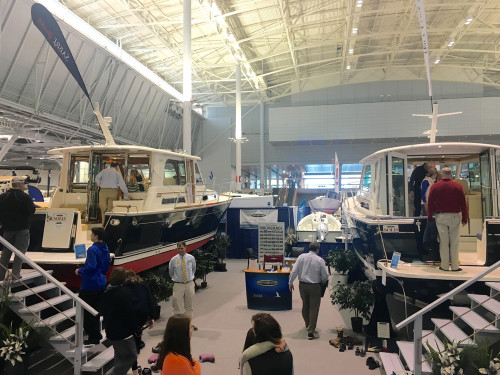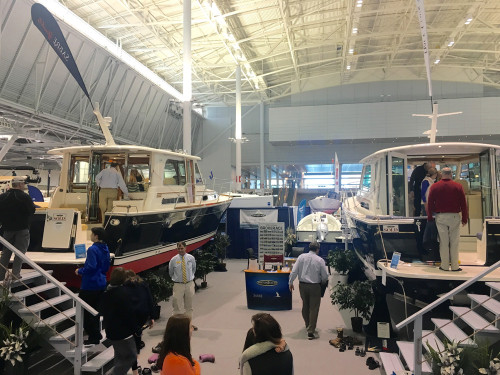This is the second part of a two part article. The first part dealt with renaming a boat and the necessary ceremony to avoid bad luck. One recovering reader responded, “like most of us I’ve come to accept the glorification of alcohol and drunkenness in society” and “we have found that we can have just as much fun, laughter, and happiness with diet coke and sparkling cider”. Alcoholism is a serious problem. My father had 35+ years sobriety from alcohol. Thus, let it be known the renaming ceremony will be just as effective with non-alcoholic beverages.
Since one objective of the ceremony is to make the God of the Sea forget your boat’s prior name, consider tossing (soon to be legal) marijuana in the water instead (unless you’re addicted to weed).
Now on to the lesser superstitions.
Bringing bananas aboard a vessel has been thought to bring bad luck since the 1700s. There are gross tons of theories as to why. One suggests that bananas spoil quickly and thus ships had to rush to their destinations, eliminating the opportunity for the crew to fish. Spiders, termites and methane gas are among the explanations for this obviously poor choice of sea food, as if we need any logical bases. This is most commonly adhered to now by fisherman.
Sharks following the vessel, whistling onboard and redheads (gingers) are bad luck. The shark is a sure sign of death. Don’t whistle aboard, you may whistle up a storm. Redheads are bad luck as they are just unfortunate to be a statistical minority. If brown hair had been bad luck we would have a history of bald sailors. Albatrosses are thought to be good luck if one is spotted, bad luck if one is killed. A “Jonah” is a person or crew member who brings bad luck. Dolphins swimming alongside are a positive omen, this one I can personally attest to as they always make me happy.
From the pirates comes a full booty of superstitions. Gold hoop earrings bring good fortune, gold provides healing powers and prevents drowning (unless you have too much). Tattoos have many magical powers. A North Star tattoo can help guide you home. Ducks or pigs tattooed on your feet will help you reach land if you fall overboard. Cutting hair or nails or shaving beards brings bad luck, baseball players share this one. Clearly there is crossover between land and sea superstitions.
There are many bad days to set sail, December 31, the first Monday in April, the second Monday in August, Thursdays and most commonly Fridays. I did a job for a commercial customer recently who will not begin a voyage on Friday and his business is doing well.
Red sky at night a sailor’s delight, red sky in the morning sailors take warning. Brief research suggests this has scientific validity and is alluded to in the Bible (Matthew 16:2-3).
Historically sailing was (and is) a dangerous occupation and superstitions helped sailors deal with the unknown. Today we have weather satellites, hair dye, man overboard drills, steel ships and refrigeration. Thank God (of the sea) for steel ships and refrigeration as Dole brings ship loads of bananas to the 10th avenue Marine Terminal in San Diego regularly; imagine the load of bad luck we might otherwise have suffered?
Comparing Boats on different Coasts
I began my career as a marine surveyor working for a Ft. Lauderdale, Florida based marine surveying company in 1990. I was born in San Diego to a U.S. Navy family but “grew up” as an active boater in Florida. I moved back to California in 1993 and have lived in San Diego since.
Returning to California as a marine surveyor I noted the difference in the value of boats from coast to coast. I just returned from a trip to Florida where I surveyed a Cabo 35 for a repeat client. I was there for a family wedding and used the job as a therapeutic break and a write off. The job reminded me of the difference between boats on different coasts.
The Coast Guard’s recreational boating statistics (2014) state California has 728,679 registered boats and Florida has 873,507 registered boats. The California number declined significantly from the prior year and the Florida number increased slightly. I found several interesting websites with statistics, links are at the end of this article.
Putting values on boats in the early 1990s included researching B.U.C., N.A.D.A. and A.B.O.S. value guides. The value guides suggested upward adjustments for boats in California.
I independently noticed that vessel values were higher in California, often significantly more than the cost of transporting the boats. My recent survey follows this higher value pattern.
Boats in Florida are exposed to much harsher atmospheric conditions, more sun, heat and often more usage. The very top of Florida is 31 degrees north latitude and Key West is south of 25 degrees north. San Diego is 32 degrees north, the southernmost point of California.
The weather affects the California boating season (May through September) much more than Florida. The air and water temperatures are much higher, the sun does more damage and boats are used more often in Florida. Florida has an intercoastal waterway, allowing usage of many boats when the sea conditions are unfavorable for boating.
I have always noticed a higher valuation for California boats compared to Florida boats, with the delta in values reduced during recession years. Florida brokers report that inventory of quality boats is low, just like California. Both states were affected by the recession and accompanying lack of boat production six to eight years ago.
The takeaway is that a boat’s value is difficult to determine based on year, make and model alone. As we all know, condition is a significant factor and statistically our local boats have a higher value because they are in better condition than boats in Florida. Unfortunately for my recent client, even a California bred boat can be affected by the Florida sun and he passed on the deal.
While researching for this article I found many interesting statistical websites, including the number of registered boats, boats per capita, value of the marine industry overall per state and casualty statistics. One statistic suggested that Arizona has the most registered boats per capita, due to their state requiring registration of all types of watercraft including those without power. I also found it interesting how many more power boats there are than sailboats, also possibly an anomaly affected by the requirement to register boats with power.
uscgboating.org/library/accident-statistics/Recreational-Boating-Statistics-2014.pdf
nmma.org/assets/cabinets/Cabinet222/Florida_2015%20Infographics.pdf
nmma.org/assets/cabinets/Cabinet219/California_2015%20Infographics.pdf
statista.com/statistics/184587/number-of-recreational-boats-in-the-us/
phoenix.about.com/od/lakes/l/blboats.htm
An Interesting trip to CUBA
My wife and I, two bilingual (Spanish) children and a non-Spanish speaking adult couple took a 10-day trip to Cuba in April 2016. I thought boaters would be interested due to their sense of adventure, travel inclination, island lore and some boating trivia and activities.
We arranged our trip ourselves, but encourage the use of Canadian travel agents. We flew out of Tijuana through Mexico City to Havana. In Mexico City we wrote our own official permission slip. The U.S. still allows visits for one of twelve purposes. We traveled under education / people to people, and will keep our itinerary for five years in case the State Department asks for it.
We visited Havana, Varadero and Vinales. The other couple visited Guardalavaca. They flew Cubana Avacion to Holguin, including a flight on a Russian built jet. This is in the area of Guantanamo Bay. Besides a 7-hour delay, their flight was normal.
We stayed mostly in houses or rooms rented through Air BNB (Casa Particulares). We found the Cuban people to be extremely friendly. There has a slight rise in petty theft recently, but we felt very safe. The Cuban’s were willing to speak openly about all subjects, including politics. Chinese we encountered in a previous trip to China were reluctant to speak so openly, though we speak much more Spanish than Mandarin and the language barrier was certainly a factor.
Interestingly no Cuban that we met had ever been off the island. An average to high-end job pays $25 a month. It’s hard to pay for a trip off the island at that pay rate even if one could navigate through the complexities and time consuming paperwork. The average Cuban works to pay for the food.
The food was mostly poor. Prices were fairly standard, but only in the occasional private restaurants (Paladares) could we find good food and to find them you had to dig deeper than just asking the taxi cab driver or taking the advice of a restaurant hawker on the street. Most buildings are in a state of disrepair. And the cars are a mind-boggling time travel experience.
Cuba has three eras of cars, the American era of the 1950’s, the Russian era of the 1970’s and the current era of the Chinese cars and busses. Every imaginable American car from the 1950’s is operating on the streets of Cuba, some with original engines and many with German and Japanese diesel engines.
The beaches were nice as one would expect on a Caribbean Island. We swam in a fresh water fed cave. We boated in an underground river and we experienced spectacular views overlooking cigar tobacco farming valleys. We watched a farmer roll a cigar and we smoked plenty of them.
We took a Hobie Cat on a snorkeling excursion to a coral reef. On that day diving visibility was moderate, the reef was average but fish were plentiful. The guides were throwing bread into the water and laughing at the tourists’ reactions to the boil of fish around them. I couldn’t help myself and joined in, throwing more fish food about the unsuspecting tourists, contributing to the fish mischief. Our guide tickled a lobster out of a hole to bring home.
I visited a marina in Varadero. The marina was new but empty. A handful of private yachts were scattered in the outer portions of the marina and a dozen 100-foot Fountaine Pajot passenger carrying catamarans were in the front row. The government runs most of the tours. The rum, the cigars, the restaurants, hotels and rental cars are all predominately operated by the government and most prices on these commodities are fixed throughout the country.
The yate “Granma” holds a special place in Cuban history. Eighty two rebels embarked on a miserable 1,200 mile journey from Mexico to Cuba aboard the 43’ boat. The rebels included Fidel and Raul Castro, Ernesto “Che” Guevara and Camilo Cienfuegos. The Batista government knew they were coming and tried to find and stop the “Granma” but it landed in Cuba, discharged its passengers and gained entrance into the Revolutionary Museum in Havana. A lot more impactful than the local smuggling pangas.
The private economy is beginning to develop but in this regard Cuba is far behind China.
There were only a few street hawkers. They generally were selling black market cigars, rum and promoting restaurants. I encountered nobody selling any drugs or prostitution, as is common in many countries. I was told prostitution is active, but it is illegal and not publicly promoted.
There are two currencies in Cuba, one is the national currency (Moneda Nacional or CUP) and the tourist currency (CUC). Tourists trade their money only for CUC and U.S. dollars are hit with a 10% exchange fee in addition to the normal money change fee of 3%. Bring Mexican Pesos or Canadian Dollars, they only get charged the 3% fee. Money changing is a government service and the rate is the same at the airport, banks or hotels. Use of American credit cards is very limited and also subject to a financial penalty.
The official U. S. Government position for bringing products back from Cuba is a $400 limit with only $100 of cigars or liquor. My buddy is enjoying his $100 box of Cohibas.
I decided that if I was Cuban, I would be a diving guide. I would get to boat, dive and interface with people regularly. I would get a little extra money from tips and eat lobster for dinner.
When Size Matters
“Hatteras’ specifications list the boat length as 50’ 3” and that is what I would like on my survey”. This was a recent request from a client who had just purchased a 2003 Hatteras 50 convertible. “And I would like to be referred to as Sir Kells, bring peace to the world and arouse women when I walk into the room”, I thought, though I responded “well let’s see if I can help”.
“I measured your boat and usually I am close. I measured 53’ 4”. I would be happy to measure it again”. I continued, “Boats are rarely the length that the manufacturer specifies or the broker lists”. Of this I am certain. But why? How are boats measured?
Per the 2009 version of the U.S. Coast Guard’s Simplified Measurement Tonnage Guide (uscg.mil/hq/msc/tonnage/docs/TG-1_Current.pdf), the overall length is the horizontal distance between the outboard side of the foremost part of the hull and the outboard side of the after most part of the hull. It does not include bow sprits, rudders, outboard motor mount brackets, swim platforms that do not contain buoyant volume and other similar fittings and attachments that are not part of the buoyant hull envelope.
We measure vessels length overall (LOA) and we do include swim platforms and bow sprits. This is the most useful length, as it is the length used by most marinas and yacht clubs. For our purposes we do not include the anchor hanging over the bow or the tender hanging on the transom, these can always be removed. While permanent fixtures such as swim platforms can be removed, it is not simple.
We rarely refer to length on the waterline (LWL) or length on deck (LOD) as these lengths are generally only useful when discussing designs and theoretic hull speed.
The Coast Guard defines overall breadth as “the horizontal distance taken at the widest part of the hull, excluding rub rails. This measurement is rarely disputed. Another important measurement of a boat’s width is the breadth at the waterline, as most boats are much wider at their rub rail (flair) than they are in the water and can thus fit into a slip which is not as wide as the boat.
The Coast Guard defines overall depth as the vertical distance at or near amidships from a line drawn horizontally through the uppermost edge of the skin (excluding the superstructure) to the bottom skin of the hull, excluding the keel. This length is not the vessel’s draft. Thus the depth on your Coast Guard documentation should not be confused with your vessel’s draft. We measure draft as the distance between the waterline of the vessel and the deepest submerged part of the vessel, be it keel, propellers or rudders. This is the minimum depth of water your boat needs to remain happy.
The Coast Guard allows simplified measurement for the calculation of tonnage. A discussion of the meaning of tonnage was addressed in a prior article and can be found on our website (https://themarinesurveyors.com/a-primer-on-displacement) it is not a measure of weight.
The boat’s length thus can vary, but it only varies based on the specific definition of the length that is sought. It is neither shorter when you are paying for a slip (or marine survey) nor longer after a couple scotches.
Do I trust my broker? Part two
A client who had a bad boat selling experience said, “The only power a boat seller has in the transaction is the right of refusal.” While ultimately true and though California law protects buyers more than sellers, there are ways to prevent many of the problems my client experienced.
He was unfamiliar with the process and made himself and the boat available to a potential buyer many times, got underway three times and then had an 11th hour offer reduction of one third of the agreed purchase price. The deal fell through and he came to me to discuss various survey findings and the apparent sales practice that he found distasteful.
For those unfamiliar with the boat buying process, it begins with an offer, then a counter, then an agreement with time constraints for marine survey and sea trial and then another time constraint to close the deal. Researching with the several local brokers, the average time from contract inception to survey and sea trial was 14 days and another 7 to 10 days to close. The contract includes purchase price, refundable deposit amount and other terms. Marine survey and sea trial are performed for the buyer to gain knowledge of the condition and value of the boat. After the survey and sea trial many boat deals are re-negotiated. The seller is not obligated to have repairs done or allow any concession in price, but they often do so if justified by the survey’s findings.
Our client’s problems were twofold; he gave more time and energy than most sellers during the sales process and then faced a significant reduction in the offer price after marine survey and sea trial. The reduction in the offer was based on findings during the survey and sea trial, per the buyer’s broker. Several of the findings, including blisters on the hull bottom were known to the seller prior to the survey.
To avoid last minute re-negotiations for known conditions, I suggest full disclosure in advance of survey and sea trial. I don’t recommend putting all the boat’s warts on the published listing, but I do suggest disclosing them prior to survey, especially things like blisters. Older boats come with blemishes and they are cheaper than new boats. Price the boat fairly, disclose the known deficiencies of significance and many of the psychologically challenging aspects of the sales process will be removed.
Some sellers make it clear that they will not reduce the price after survey, often because they feel the offer is less than the actual value of the boat. Some sellers offer a maximum survey allowance in advance. These tactics may prevent a low ball last minute offer reduction by an unscrupulous buyer by deterring them at the onset of the deal.
An English article on this tactic calls it “chipping” or “gazundering”. We can’t know if this tactic was consciously deployed in this instance or if the buyer just had a change of opinion of value, but the results for our client were the same, negative.
Find the article at http://www.thisismoney.co.uk/money/mortgageshome/article-2400872/Chipping-new-gazundering–buyers-reneging-agreed-sale-price-And-plain-wrong.html
Do I trust my broker? Part one
Having been asked this question repeatedly at our booth in the recent San Diego boat show and many times over the years, I decided to publish my answer.
Since we are a marine survey company, a question we often field from prospective boat buyers is “Can I trust my broker’s recommendation for a marine surveyor?”
To use a baseball analogy, this is a “hanging curveball”. I’m at bat with bases loaded and no outs! Boat broker and marine surveyors are often at odds and I have suffered the blows of many brokers’ verbal bats.
Still my answer is, “If you trust your broker, you should trust their recommendation for marine surveyor, lender, insurance company, boat yard, mechanic, etc…, After all you trust their advice on the boat, right?”
I ask if the potential boat buyer is working with a broker that found the boat for them or if they found the boat and the broker came along, becoming their broker and the broker for the seller. This doesn’t disqualify the broker‘s referrals but the new relationship will not manifest the same trust as one developed over time with someone searching listings for you and taking you out for viewings.
I see no ethical dilemma in brokering both sides of the deal – it is common, and the broker either is or is not ethical. Of course having one broker versus two creates some ethical challenges and raises the possibility of an appearance of a conflict of interest. It must be tricky to advise the buyer on a proper offering price when the broker already knows the seller’s bottom line. A dedicated broker could logically be more aggressive in negotiating but the shared broker might have more influence.
If there is any question that the broker’s referral(s) are not in your best interest, don’t dismiss them, but also do your own research. The marine industry is a “small world”, ask marine industry professionals for referrals. We all know each other’s reputations. Network with marine surveyors, lenders, insurance agents, boat yard operators, mechanics and maritime attorneys.
Ask for several referrals instead of just one and compare the lists. Ask your boating neighbors and friends. Search the internet, but be careful to not be influenced by one fanatical supporter or detractor. “Due diligence” in this case does not take long and is simple.
On the other side of the coin, I just met with a repeat (marine survey) client of mine who had a bad sales experience as a boat seller, and realized many of our clients don’t go through the vessel selling process often.
In Part 2 of this article, I will share my experience on the boat selling transaction side, which I hope will be helpful.
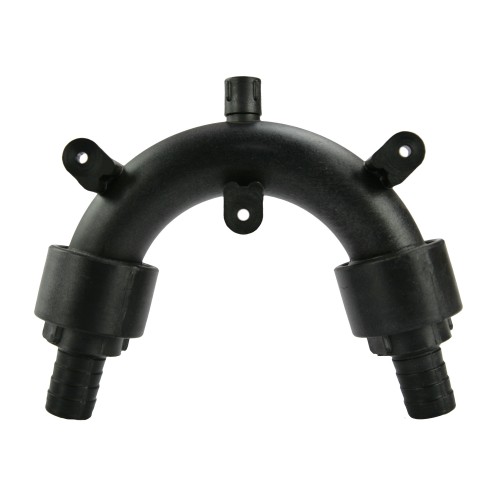
Keeping Water on the Outside – Siphons
“Nothing good ever comes from water in the bilge.” Jim Merritt, marine surveyor and mentor.
All of the submersion claims we have ever handled have the same cause of loss… too much water on the inside. In order to maintain a boat without water inside we employ valves, loops and siphon breaks, but sometimes this simple concept is misunderstood. The systems that normally require these measures are engines, heads and bilge pumps.
![xe2QGYr9D3_Vented_Loop_Anti-Siphon_Valve_1[1]](https://themarinesurveyors.com/wp-content/uploads/2016/03/xe2QGYr9D3_Vented_Loop_Anti-Siphon_Valve_11.jpg)
To prevent siphoning we install siphon breaks, usually in the form of vented loops where the top of the vent is above the maximum healed waterline and the break is a way to allow air into the top of the loop.
Bilge pumps should discharge above the waterline, but those that do not require a siphon break. A vented loop is acceptable per A.B.Y.C. standards but a check valve is not. A check valve can only be used to prevent cycling of the pump, but configuring the pump and float to eliminate the cycling is smarter.
Heads mounted below the waterline require means to prevent flooding. If you leave the intake valve open and the head overflows, this is not siphoning, this is flooding (unless your through hull is higher than your head). In this case a simple loop, unvented, would have prevented the flooding as water seeks its level. A simple trick to know the waterline on the interior of your boat is to have a hose full of water contiguous to the sea, the water level in the hose is the water level in the sea.
Heads that discharge above the level of the top of the head do require vented loops and the vents only work if they allow air into the loop. Vents require maintenance, a clogged vent in a vented loop is just a loop and does not prevent siphoning.
Engines installed at or below the waterline require a loop in the exhaust discharge to minimize the possibility of inflow of raw water, whether the engine is running or not and a siphon break to prevent siphoning through the raw water pump when the engine is stopped. The water lift muffler is below the raw water intake through hull and in certain situations a solid column of water can form between them, eventually filling the muffler and engine with water. A functioning siphon break, usually between the engine and the muffler prevents the flooding. Over cranking this type of engine will also flood the engine with water. If the engine won’t start, shut the through hull while you remedy the problem but remember to open it when the problem is solved.
This is not meant as a “how to keep water out of the bilge” article nor does it address thalassophobia (fear of the sea). There is apparently no name for fear of water in the bilge, perhaps boataquaphobia.
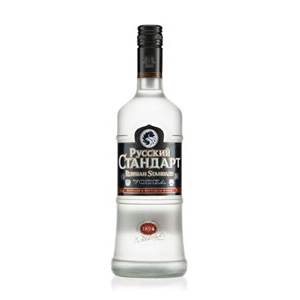
Another Use For Vodka
This month’s article was inspired by Mr. Jim Montrella. Mr. Montrella owns a 2000 Formula 31 PC express cruiser in Dana Point Harbor named “H20 Man”. I met him when I handled an insurance claim for his insurance company and he called us a year later when he needed a condition and valuation survey on the same boat. He keeps the boat in good condition and during our recent inspection he mentioned that he uses vodka to purify his boat’s water system.
I have been around boats a little while and have been blessed with talking about boats with tens of thousands of people in the last three decades, but Jim was the first to mention this trick. I had always deferred to chorine bleach. I had been told early in my career, perhaps during marine surveying catastrophe duty after Hurricane Andrew (August 1992 – South Florida), bleach could be used to purify water and would not be injurious to humans when consumed.
![th[6]](https://themarinesurveyors.com/wp-content/uploads/2016/03/th6.jpg)
Most of the research deals with survivalists and some was very technical. Did you know alcohols precipitate proteins and solubize lipids? (I’m betting two of you did.) I tried to get a feel for our specific interests, boat water tanks and it turns out many people use vodka for this purpose. Basically there was no consensus on the proper amount but the ethanol in vodka is effective against a wide spectrum of bacteria. The impurities remain in the water, so it is not a replacement for the much more expensive option of a water maker, but for the purpose of purifying the tank and system, it is effective.
Vodka is the most commonly used drinking alcohol because there are no additives in common vodka. I am thinking Popov level of vodka makes more economic since than Grey Goose and certainly don’t use flavored vodka. Make sure you don’t have any recovering alcoholics coming aboard, lest they unknowingly lose their sobriety.
I asked two doctors about this method of purification. One is an old friend and one I randomly met recently on a golf course. It was very interesting that they both gave the same answer to my query, why waste the vodka?
Based on the research, I feel vodka is an effective additive, and the benefits outweigh the draw backs. I certainly am more comfortable drinking vodka than I am drinking bleach. The smell of bleach is unpleasant and though I prefer tequila, I can certainly tolerate a bit of vodka, especially if it reduces the chance for unpleasantries like giardia.
By the way Mr. Montrella has recently begun chartering that smartly kept boat of his, so if you are interested in a boat ride up Dana Point way, send us an email and we will forward it to him. I can’t guaranty that he will have recently cleaned his water tank, but his boat will be in good condition.
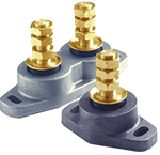
Motor Mounts
![118213_BUS_DF-100_PPM[1]](https://themarinesurveyors.com/wp-content/uploads/2016/03/118213_BUS_DF-100_PPM1.jpg) As a marine surveyor, I occasionally encounter problems with motor mounts, and I wondered if there was a more analytic (and less subjective) way to determine their condition. I spoke with several experienced marine mechanics, a distributor and a manufacturer.
As a marine surveyor, I occasionally encounter problems with motor mounts, and I wondered if there was a more analytic (and less subjective) way to determine their condition. I spoke with several experienced marine mechanics, a distributor and a manufacturer.
The vulcanized rubber in flexible or soft motor mounts provides sound and vibration dampening. It is this rubber that is most commonly damaged. Apparently, a visual inspection is the only way to determine the condition of the rubber in the mounts. One mechanic mentioned using a durometer, but he had never used one. Petroleum products, heat and age cause damage to the rubber. The metal is most commonly damaged by corrosion. Mounts also suffer damage from improper installation, under-sizing, hard shifting, groundings and hard landings (for those of you with boats that fly).
Separation of the rubber from the metal, sagging and distortion are the usual indications of damaged rubber. High performance boats and some older yachts use solid mounts, with no dampening rubber.
Occasionally we find broken motor mount studs; a much more definitive indication of a problem mount. Amazingly of all of the broken studs we have found, none of the operators were aware of a problem as the other three mounts supported the engine load. We commonly find the “jam nuts” not properly secured against the adjustment nut. If there are two nuts on one side of the engine’s mounting flange, they should be touching.
So the next time you are “messing about” we encourage you to inspect your boat’s motor mounts. Some may need a mirror and a flashlight. Inspect the rubber, the stud, the nuts and the bolts securing the mounts to the engine bearer. Damage claims involving catastrophic motor mount failures are few, but they usually include significant water intrusion about the propeller shaft seal and chaos. A brief check of mounts along with your normal pre-start check may prevent something much more catastrophic.
Replacement mounts and/or mount parts are available from engine manufacturers and sometimes only from the OEM$. The largest US based motor mount manufacturers are Barry Controls and Bushings, Inc. While there are no age specifications for motor mount life expectancy from the engine or motor mount manufacturers, the military specifications for many marine motor mounts is seven years.
The bad news, there is no objective inspection or test for motor mounts. The good news is if you keep the mounts clean and free of shock loads, they may outlast you.
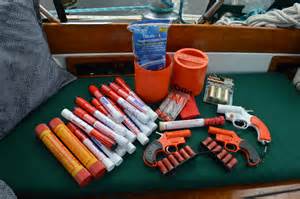
Marine Distress Signals
![th[5]](https://themarinesurveyors.com/wp-content/uploads/2016/03/th5.jpg) There are numerous types of distress signals, they include pyrotechnic aerial/parachute and hand held, smoke signals, various types of lights, including man overboard strobes, lasers, radio signals, E.P.I.R.B., V.H.F. /radio signals, dye markers, U.S. and International flags, waving arms, sounding a continuous horn, firing a gun at one minute intervals and of course S.O.S. in Morse Code.
There are numerous types of distress signals, they include pyrotechnic aerial/parachute and hand held, smoke signals, various types of lights, including man overboard strobes, lasers, radio signals, E.P.I.R.B., V.H.F. /radio signals, dye markers, U.S. and International flags, waving arms, sounding a continuous horn, firing a gun at one minute intervals and of course S.O.S. in Morse Code.
The most commonly thought of marine visual distress signal is the pyrotechnic flare.
In 1859 Martha Coston was granted a U.S. patent for a pyrotechnic night signal and code system. Today, recreational boaters in the U.S. are legally required to carry three day and three night distress signal flares. The flares must be labeled U.S.C.G. approved and must be current, they have 42 month service lives.
Pyrotechnic flares approved by the International Convention for Safety of Life at Sea (SOLAS) are much better than U.S.C.G. approved flares without a SOLAS designation. They shoot higher, last longer, have higher candela and cost much more.
Since most of us have never shot a parachute flare or ignited a hand held flare, smoke signal or dye marker, consider checking them out on YouTube.
Boaters can learn how and when to use the various types of distress signals. There are also many videos about laser flares or electronic visual detection signaling device (EVDSD). These devices are a no brainer in my opinion, not as a replacement for pyrotechnic flares, as they are not legal replacements, but as a supplement. They can be used for a much longer period of time and thus not necessarily only when another vessel or a plane is in sight. EVDSDs do not create as much pollution as pyrotechnic devices which are considered to be explosives and are hazardous material.
Never throw pyrotechnic flares overboard, in the trash or activate them in an area considered to be regulated water. In an interesting research experiment I contacted three local authorities and a large marine retailer and asked how to dispose of expired flares. Two provided the correct answer, but one provided the number for a local small retail company that is now defunct and the large retailer provided incorrect information, in fact the individual said the local fire department would not take the flares. In my area, Shelter Island, San Diego, fire station #22 (1055 Catalina Blvd.) will accept expired flares and most fire stations will do so.
Keeping older distress signal flares is common and a common recommendation on our survey reports. Most people just forget about them, but they are a legal requirement and expired flares do not meet the requirement. Many of us believe that expired flares will work and they may, however I once read an article in a non-commercial magazine (like Practical Sailor) that found the cheaper flares’ performance significantly decreased after their expiration date.
In my opinion, keeping a few extra flares (even if expired) is a good idea, but new SOLAS flares, an EVDSD and a few minutes of education on YouTube will increase our chance of both getting rescued and rescuing others in distress.

The Joys of Boating
 “There is nothing – absolutely nothing – half so much worth doing as simply messing about in boats.” is the only thing I have ever read by Scottish novelist Kenneth Grahame, but how profound. If you are reading this, perhaps you agree.
“There is nothing – absolutely nothing – half so much worth doing as simply messing about in boats.” is the only thing I have ever read by Scottish novelist Kenneth Grahame, but how profound. If you are reading this, perhaps you agree.
I recently inspected a 1960s era wooden power vessel being purchased by a young couple from a young couple. “Young”, by the way, is getting older every day. I find sharing experience and knowledge of boats deeply rewarding. Being allowed to assist in this particular transaction, interacting with these hopeful and energetic souls and experience their mutual joy was profoundly rewarding in a Kenneth Grahame way. I was filled with satisfaction and appreciation and smiled as I walked out of the wood boat yard, at the end of the row of boatyards, and carried my tools the short distance to my car.
Perhaps its maturity, but after 25 years of messing about in boats (as a marine surveyor), I love my job and am eternally grateful for opportunities like that one.
In the past few years I have been involved in two “refit projects” simultaneously. One is a San Diego built wooden 38’ sailboat and one is a Japanese built steel 45 meter motor vessel. The sailboat is being refit to be structurally sound and suitable as a live aboard, the motor vessel is being refit from a commercial boat to an expedition yacht. Hugely different projects but at their core they are the same.
The meetings with the owners concern things like the ability to accomplish passages safely, have accommodations that make the most of the available space, and toys that maximize the fun while aboard. I love brainstorming with the owners about their ideas, both conservative and wild, especially when we can make the wild ones come true. While the passages may be different, one to Catalina and one across the Pacific, the passion for adventure is the same. The accommodation considerations varied from a larger head with a real door to a choice between four or five guest cabins, they both involved give and take and some amount of marine prognostication. The tender choices ranged from either a rowing, sailing or combination dinghy for the sailboat to a choice between a diesel outdrive or a gasoline jet drive as the third tender for the expedition yacht; we all knew how much fun was going to be had on the little (relatively speaking) boats.
Working on boats, being on and in and near the water is a way of life and a calling. Perhaps some of us truly are “of water” and feel comforted by being close to and involved with it. Water is an essential element in many spiritual systems from Pagans to Native Americans to Taoism. It is said that water is the strongest element as it can flow around obstacles without changing its nature. And water seems to be one of the sources of harmony with boaters.
The completion of boating tasks, from choosing a boat’s name, to replacing a water pump impeller to larger varnish and paint project brings task completion satisfaction akin to home projects but with a bit more romance. The joy that accompanies the clanking of wine glasses after the brushes are clean or the mooring lines are set is somehow deepened by the sea.
Kells Christian is the principal marine surveyor of Christian & Company Marine Surveyors, Inc. Christian & Co. is a full service marine surveying firm specializing in yacht surveys, pre-purchase, condition and valuation, damage surveys, litigation support and consultation.
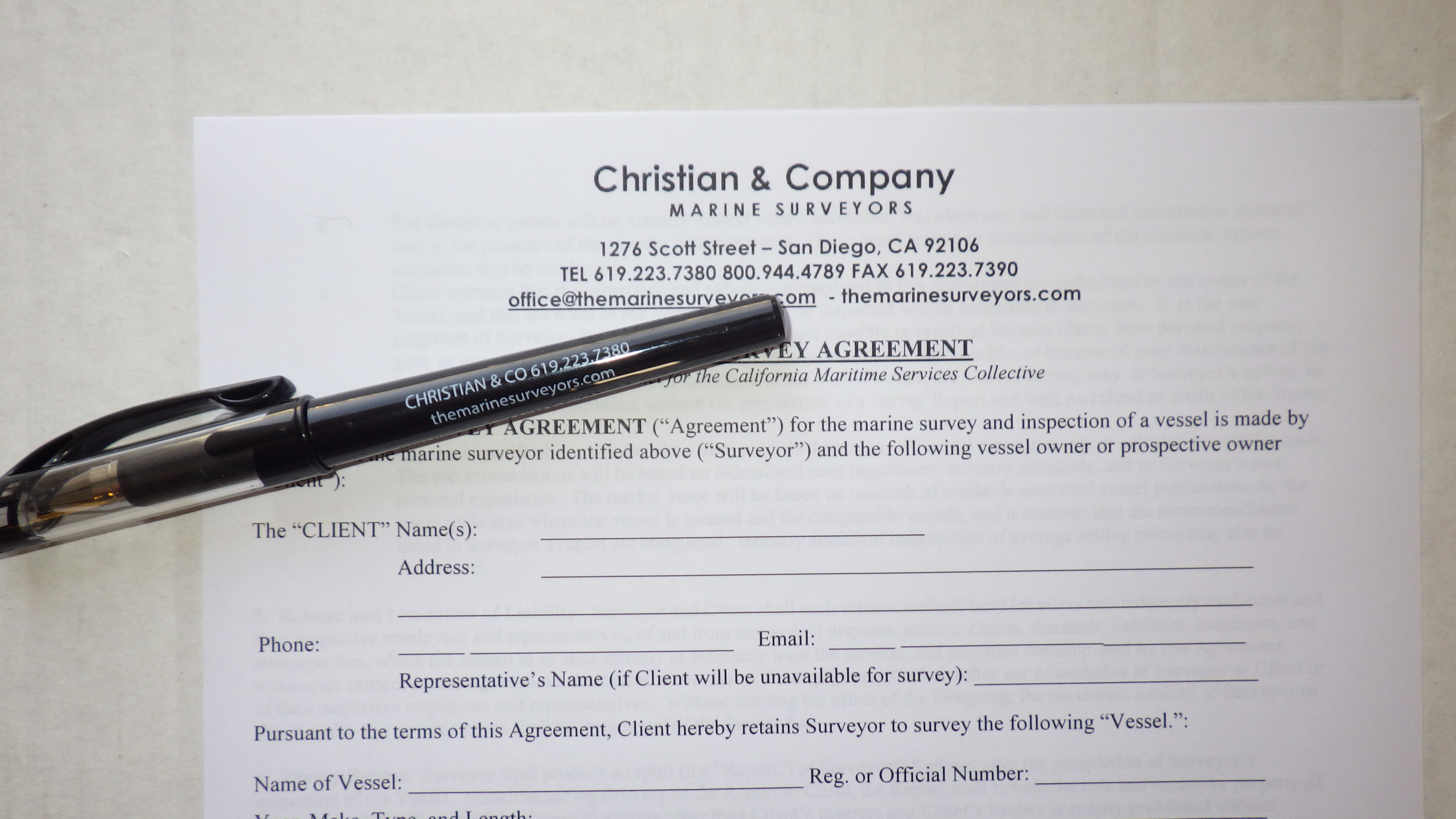
Boatyard Contracts
 A contract is a binding agreement between two or more parties. Your boat insurance policy is a contract between you and your insurance company. The work order is a contract between you and the boat yard. The clauses in these two contracts contradict and confuse and if you have an accident in the yard, you might have trouble.
A contract is a binding agreement between two or more parties. Your boat insurance policy is a contract between you and your insurance company. The work order is a contract between you and the boat yard. The clauses in these two contracts contradict and confuse and if you have an accident in the yard, you might have trouble.
What can we do? Most of us need both the service of a boat yard and boat insurance.
I firmly support the right for a business to limit its liability with a contract. Every business has this right, to the extent allowed by law, and every customer has the choice of vendors. Some contracts present more challenges than others and this article is written only as an introduction to this conundrum.
Your boat insurance policy stipulates that you cannot modify the insurance company’s legal rights or increase their liability exposure but boat yard’s work order will likely do both.
The bad news, in a worst case scenario, signing the boat yard’s work order could void your boat insurance policy in the event of a claim while your boat is in the yard. The “good” news is that it is unlikely.
Know that these types of problems may arise when you take your boat to a boat yard yourself, or when the boat is brought to the boat yard by your boat broker, captain or friend.
There are straight forward ways to avoid these conflicts. Many boat yards will allow the removal of these exculpatory clauses, hold harmless agreements, waivers of subrogation, and liability limitations. They will not do so if you do not ask. There are also special insurance riders which can be purchased to cover the gap in coverage.
This is a “hot topic” among boat yards, marine insurance professionals and maritime attorneys. Ask your boat yard, boat insurance agent and/or favorite maritime attorney if you want more details and specifics, they will give you plenty of information.
How to Maintain a Boat and Prepare for a Marine Survey
This article was inspired by a speech at a local yacht club. I was asked to speak about the importance of maintaining adequate boat insurance and how to maintain a boat for a good marine survey report. This article addresses the second part of the request; a prior article was written regarding the importance of maintaining suitable boat insurance.
This article follows logically from the first article as the tips contained herein will improve the condition of the vessel and will be reflected on a survey report. This article is not intended to be a comprehensive boat maintenance guideline. It gives a few specific suggestions based on our decades of experience as marine surveyors. Specifically we have specialized in insurance claims assistance and condition and valuation inspections.
A myriad of books have been written regarding boat maintenance. Most boat owners have a reasonably good idea of what needs to be done to maintain their boats. Hiring experts for specific systems such as engines, transmissions and generators is always advisable if proper maintenance is beyond your skill set.
While preparing for the speech and the articles a common theme sprang to mind. Pay attention to the subtle changes. Note conditions which are different in any way, it is your boat giving you a clue of how to save money.
Many insurance claims result from several unfortunate circumstances or the alignment of several problems, not just one event. Submersions are perhaps the most obvious example.
Submersions often result from a gradual leak that develops into a more substantial leak. There are often contributing causes including bilge pumps or their automatic switches which fail, or low battery voltage. Determine the low spot on the vessel and check it upon your arrival. Any accumulation of water higher than the norm should be dealt with immediately. Determine the source of the water and eliminate the leak. Remove the water to allow detection of any future leaks. A most honored mentor has told me repeatedly “nothing good ever comes out of water in the bilge”.
Check the function of the bilge pump and specifically check the function of the automatic switch. If you don’t know how to check the switch, now is a good time to learn. Make these checks part of your monthly maintenance program. Consider secondary bilge pumps, float switches and alternative power sources for the secondary bilge pump. All offshore cruising vessels should have a high water alarm, they are relatively simple and inexpensive to install.
Most vessels sink in their slip. While many vessels spend most of their lives in the slip, the most common causes of submersions are not associated with heavy weather or rough seas operations. Check and maintain the propeller shaft seals, the rudder ports, the deck drains and the seawater systems. Many hoses last ten years, have you considered the age of your hoses? A bilge pump cycle counter is another tool which can be useful in preventing a submersion or partial submersion event. But like any other tool it is only effective if it is used properly and any increase in the number of cycles is dealt with in a timely manner.
Through hulls and through hull valves should be inspected annually and serviced or replaced as necessary. We recommend ball valves or sea cocks and discourage the use of gate valves. Valves should be functional. Maintenance should be performed as appropriate for the valve. Pink discoloration of bronze is an indication of corrosion and any suspect through hulls should be replaced during maintenance haul outs. I have broken countless valves and several through hull assemblies in the normal course of surveying, unfortunately the failures were not the result of any superior strength, just through hulls weakened by corrosion. Often weeps, stains or salt crystal accumulation can alert the boat owner to a failing through hull or a valve. A quick visual inspection is often sufficient to discover this type of problem. Be sure to access and inspect the transom, as there are often fittings below the waterline. Look for rust stains and weeping trails for your visual clues to problems.
An owner of a vessel that recently submerged mentioned that he had noticed a problem with the culprit through hull and had made a mental note to change it at the next scheduled haulout, the haulout was unfortunately scheduled to far in the future. These are components that give the boat owner plenty of warning prior to failure but teach a hard lesson if ignored.
Heavy weather in the winter of 2009 – 2010 in the Southern California area gave rise to numerous boat insurance claims. (See Heavy Weather Boat Maintenance, a previous article). Make sure the canvas is suitable for the job you give it. Service deck drains and hatch drains as necessary. Take a look at the dock lines, chocks and cleats. These components will give you clues if they need something. Water standing on a drain, chafed dock lines, bent cleats (on the boat or more commonly the dock) are all precursors to more significant problems.
There are many simple things a boat owner can do to prevent or minimize damage from fire. Inspect the shore power cord connection and the boat’s shore power inlet. Replace any connectors which exhibit heat damage. Assure the locking ring is in place, provide strain relief and replace worn components as a matter of maintenance.
Assure that any systems or components which are added to the electrical system are installed by a qualified marine electrician. Over current protection (fuses and circuit breakers) are designed to prevent catastrophic electrical failures. Assure all devices have proper over current protection. Additionally, main AC and DC circuit breakers, and readily available battery switches are critical. Many electrical fires are foreshadowed by the definitive smell of over heated wire insulation. Turn off main circuit breakers and shut off all battery switches at the first smell.
Fire protection equipment should be maintained annually. Both fixed and portable extinguishers should be maintained per N.F.P.A. recommendations. While legal requirements only dictate the number and type of extinguishers and that the extinguishers are “serviceable”, we suggest more attention be paid to these crucial pieces of safety equipment. We have been involved with many engine room fires which were extinguished by fixed units. Countless lives have been saved by these devices but they are rarely maintained properly. There are tricks (daylight savings time) used to remember when to replace the batteries in your smoke alarms, use the same memory trick to remember to check and service the safety systems on your boat.
Other safety devices which are commonly found lacking in the maintenance department include distress signal flares, re-boarding devices, life rafts, EPIRBs, MOB devices and life preservers. Our rule for safety equipment is if you are going to bet your life on it, hedge your bet with maintenance. If it is aboard the boat when we survey it, it must be currently maintained and functional, even if it is not a legal requirement.
Machine systems, engines, transmissions and generators, are the most reliable system on the boat for providing clues about impending failures. While rust stains and water accumulation may whisper clues of impending failure elsewhere in the boat, machine systems often shout their warnings. Many of these clues do not require years of mechanical experience or skilled senses. Many of the clues simply require the operator to pay attention and be aware of the normal function of the machines.
Most engines are equipped with gauges. Changes in any of the gauges should illicit a response. A change in the idle speed, oil pressure or operating temperature is easy to notice if one simply pays attention. Many of the operators put physical marks on their gauges to allow for ease in determination of any changes. Small pieces of tape or similar markings on the face of the gauge where the needle usually resides is a simple trick to alert even the novice boat owner of a problem.
We request cold starts during our sea trials for potential buyers. Starting an engine cold is an excellent indication of its condition. Ideally an engine should start during the first turn of the crank shaft, instantly when the key switch is energized. A hard starting engine is a bad sign. Notice if your engine becomes gradually harder to start. Pay attention to the exhaust smoke opacity (density). It often changes gradually but it is visible on most boats. Observe the engine itself and properly address any fluid leaks (coolant, seawater, oil, fuel, transmission fluid) or corrosion. Pay attention to the sound the engine makes, among simple clues are belt squeals and water pump or alternator bearing noise. Know that every component on the engine that interfaces with seawater requires maintenance. The raw water pump, heat exchanger, after cooler, oil cooler, exhaust mixing elbow and even the sea strainer require maintenance.
Our experience has provided insight to a remarkable difference in failure modes between recreational and commercial vessel engines. A recreational vessel engine that has worn out is an oddity. Recreational vessel engines generally fail due to the failure of some component part coupled with a negligent response to this initial failure. Though the negligence is often a result of ignorance, it is nevertheless preventable. Conversely, commercial vessel operators pay attention to the clues from their machine systems, perhaps because their livelihood is dependent. The high temperature condition is addressed and the running temperature is returned to normal, before the catastrophic failure occurs. This is a simple and clear example of the difference maintenance makes. Commercial vessel’s engines live longer because of better, more active maintenance.
Similar clues are provided to sailors. Standing and running rigging weathers and corrodes. Roller furling mechanisms slowly become more difficult to operate. Sail covers rip and tatter before the sails themselves are exposed to the harmful effects of the sun.
Vessels powered by gasoline engines or vessels equipped with propane cooking, require specific maintenance. Gas powered boats are required to have forced ventilation in the engine space. We commonly find blower hoses disconnected and rendered ineffective. Any electrical component in a gasoline engine room or gasoline tank storage space is required by A.B.Y.C. recommendations and standards to be ignition protected. It is difficult to determine if the starter you are trying to purchase is ignition protected or not. One sure fire way is the price tag, but asking the vendor is your responsibility. We encourage gasoline boat owners to use their nose to detect for gasoline fumes upon arrival to the boat. If the boat is kind enough to provide a clue that your vessel has a gasoline leak, return the favor by paying attention. In the event of a gasoline odor, we encourage an uneducated operator to enlist professional assistance.
A well designed propane system provides the necessary equipment for testing for leaks. Open the solenoid valve and the manual valve on the tank. Shut the manual valve and allow the solenoid valve to remain open for at least several minutes. Note the pressure on the gauge at the time the manual valve is closed. Any reduction in the pressure is an indication of a leak in the system. We strongly encourage the use of propane and carbon monoxide alarms in conjunction with propane systems. Carbon monoxide alarms and gasoline fume detectors are also suggested for gasoline powered vessels particularly if they have sleeping areas.
We hope this list of suggestions supplements your existing maintenance program and provides some useful tips in maintaining the vessel to prevent damage and to improve the condition. This will not only allow for a better marine survey report, but a better boating experience. Pay attention to the subtle changes and you may prevent the catastrophic event.
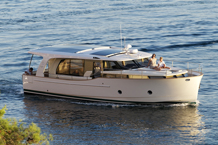
Conscientious Boating and Living
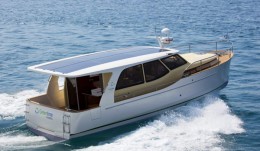 Boating and conscientious living don’t have to be mutually exclusive. There are unavoidable contradictions, the fuel burnt will contribute to greenhouse gasses and the material of the boat and supplies used will eventually be waste, but as we have raised our awareness on land, so we can at sea.
Boating and conscientious living don’t have to be mutually exclusive. There are unavoidable contradictions, the fuel burnt will contribute to greenhouse gasses and the material of the boat and supplies used will eventually be waste, but as we have raised our awareness on land, so we can at sea.
The emission issue is being actively addressed by our local community. The state has bought and continues buying low emission engines for many commercial boats that qualify under the Carl Moyer Grants program. Buying modern, efficient engines and keeping them maintained reduces emissions.
There was a full sized electric boat at the 2015 San Diego boat show and it was nice. There are many small electric boats. We can run the generator less, use an inverter or solar or wind. Choosing the “higher good” often comes with a price, less speed, less range and more money, but mother earth, our descendants, fisheries and coral reefs are worth it. Sailboat owners get a nod in the never ending battle with power boaters, but boating footprints encompass much more than engine emissions.
Thankfully more and more companies are able to provide green choices at the retail level and will continue to do so if they are supported. When we buy products for our boats (and homes) consider their impact. Soaps are important, there are so many, boat washing, dish washing, body washing, bilge washing, and it all goes into the ocean. Paint choices are also important and the industry and the San Diego Unified Port District have and are subsidizing environmentally friendly anti-fouling paint.
Reuse, repurpose, recycle. If we keep this in mind when we shop and consume, we can reduce waste. Reusable water bottles, dishes that we wash rather than throw away, cloth instead of paper wipes, rechargeable and/or longer lasting batteries and yes, there is a cost of both time and money. There was a marine surveying company giving away reusable shopping bags at the boat show :>).
Our boating group consciousness has been raised regarding trash in the water. Like the crying American Indian of our youth, the Pacific trash gyre and the tireless efforts of many are keeping our trash contained. Good job boaters, now let’s all go that extra step and keep a recycling container aboard too.
Some actions save money and are good for the environment. We can change settings on refrigeration units, air conditioners and water heaters. We can service systems so they operate efficiently and we can turn them off. Did you know your refrigeration devices should never “ice over”. If you have ice buildup in a refrigeration unit, it likely has a bad seal, compressor or thermostat. “That’s normal” is incorrect.
I am a wood boat lover, but we are a plastic boat community. In Chula Vista fifty foot wooden boats are being cut up daily. While the wood is organic and will eventually deteriorate, it goes to the dump to do so. I tried to repurpose one into a deck and the labor cost was too high, I am looking for suggestions and if you have any you may be able to help the cause and your bank account. There is plenty of source material for “distressed boat wood”. The same company is trying to acquire a fiberglass recycling machine to keep our exhausted fiberglass boats out of the dump, kudos to San Diego Bay Marine.
For the good of all, let’s keep the boating community thinking globally and acting locally.
A good reason for a survey – fiberglass laminate issues
In an old article entitled “Why we tap your hull” we discuss reasons that we tap on or percussion test boats. Percussion testing is used on wooden and fiberglass vessels, both single skin (solid) and composite (cored) laminates.
Many times we find small innocuous problems such as voids in the deck, but occasionally percussion testing reveals a more significant condition.
During a recent pre-purchase inspection of a 50’ luxury sportfisherman an anomaly was found during percussion testing. Initial tapping was done with a plastic/phenolic hammer (less cosmetic damage) and after an anomaly (different sound) was detected, a metal hammer (more definitive sound) was used to confirm the finding.
The area was on the starboard hull bottom and was approximately 3’ in diameter. The area sounded different than the rest of the hull bottom and subsequently we noted that it would flex with manual pressure applied.
The broker attended but neither the buyer nor seller were present during the survey. We requested that the fiberglass expert from the boat yard have a look at this problem while the vessel was hauled.
An agreement was reached between buyer and seller and a week later the potential buyer asked that we monitor the repair. The boat yard began by removing a coupon of the laminate with a hole saw. In this area the external fiberglass skin was not attached to the foam core, but the foam core was attached to the internal fiberglass skin. A few cuts later and the “never bonded” external skin was removed, leaving foam core exposed over a 3’ x 5’ rectangular area. No water was found in this area.
Three layers of a modern laminate were applied using a vacuum bag, the area was faired and several days later the hull bottom percussion tested normally.
Not all surveyors perform percussion tests. Most of the time the entire boat is not percussion tested, i.e. the upper portion of the hull sides that are inaccessible without moving a ladder slowly around the boat. We usually tap out the deck and bottom and the hull sides we can reach, but we certainly don’t tap every square inch. In this instance we performed our normal inspection and fortunately found this problem area.
I wouldn’t go so far as to use the cliché about the blind squirrel (who sometimes finds a nut), but luck is a useful tool in this surveyor’s bag.
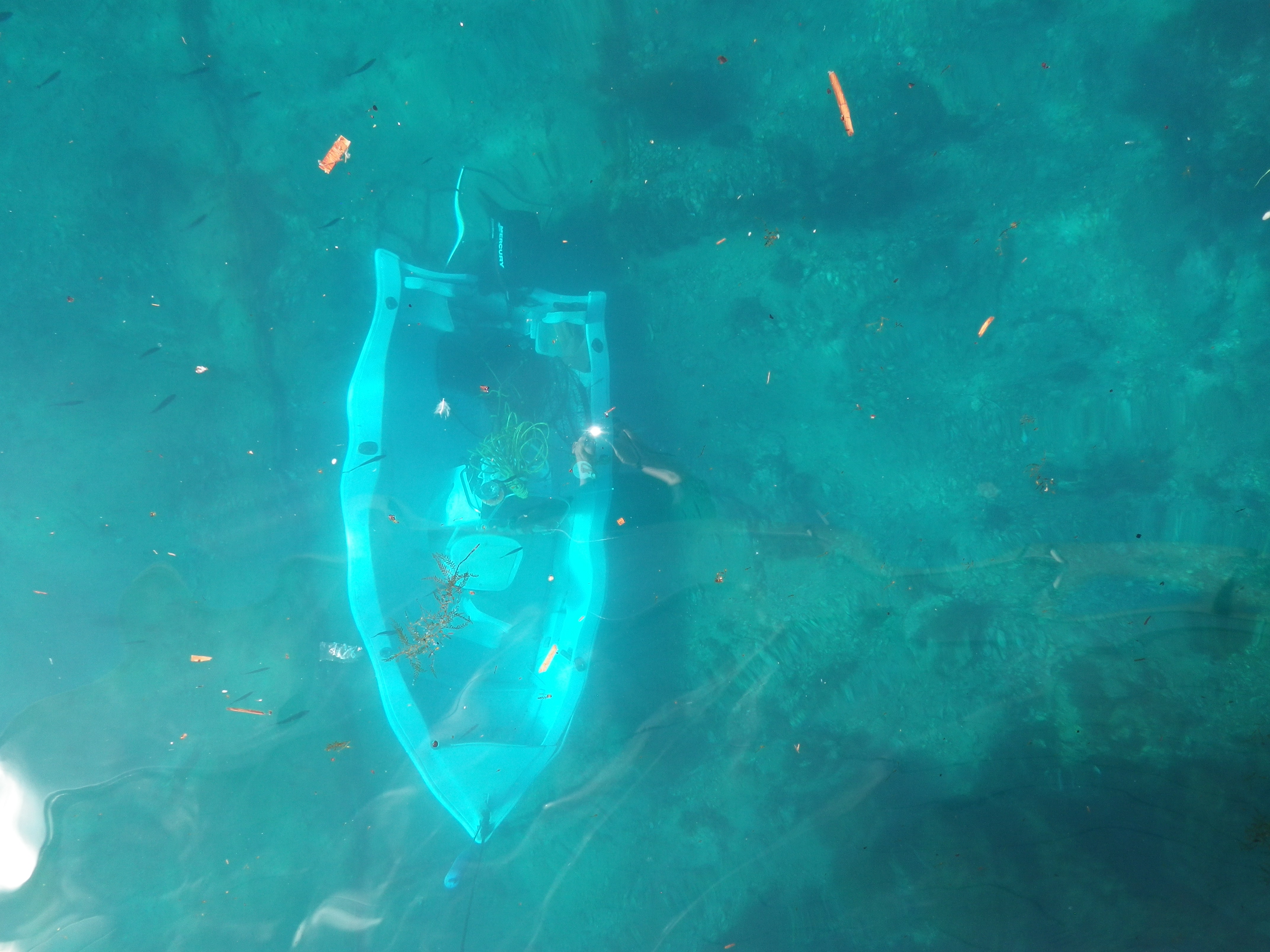
When the Little Things Matter
On December 30, 2014 an unusual weather event struck the harbor in Avalon, Catalina Island. Storm conditions resulted in property damage and tragically, the loss of two lives. Boats can be replaced or repaired. Our most heartfelt condolences extend to families and friends of Bruce Ryder and Tim Mitchell.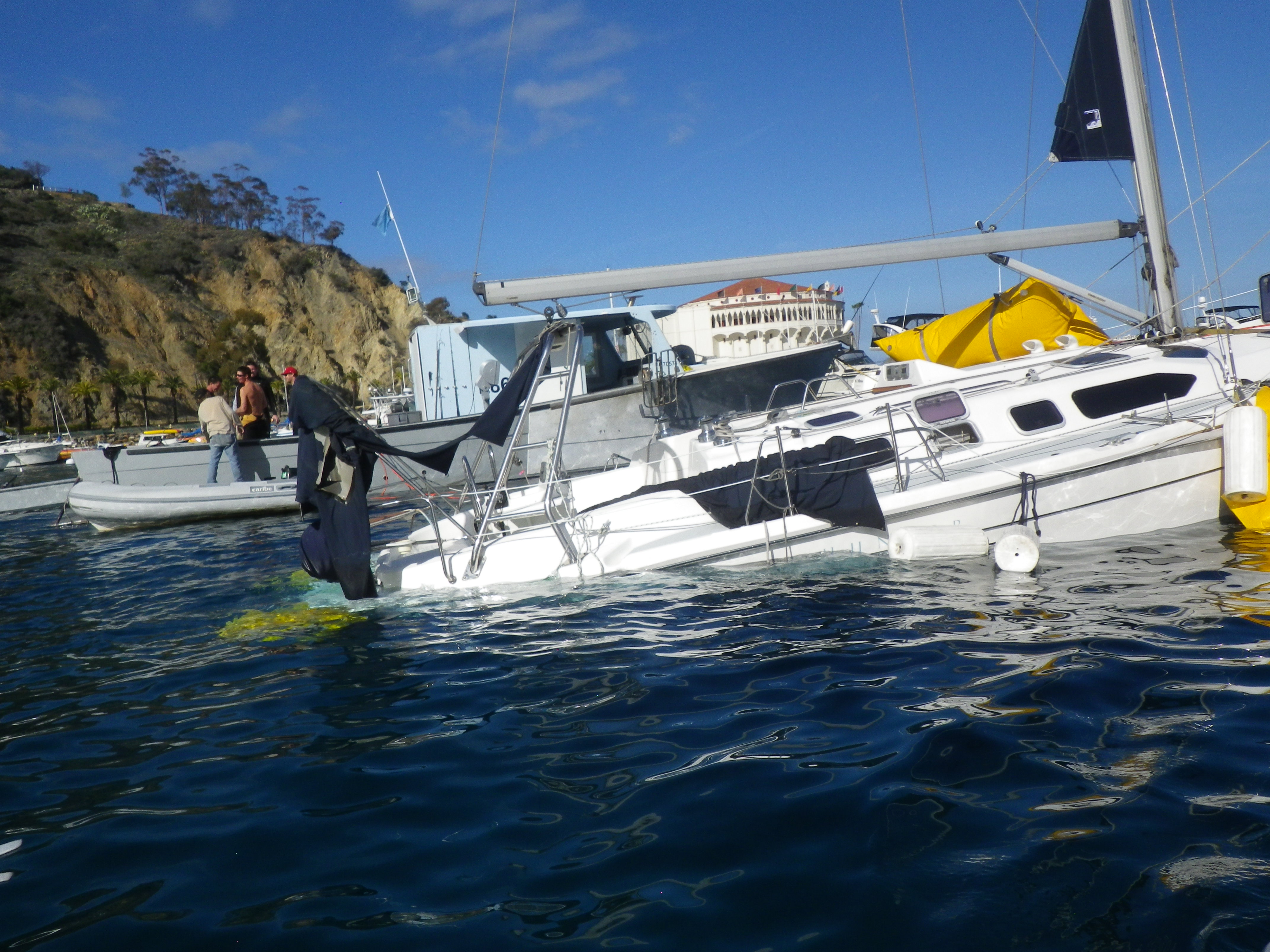
Property damage included boats on the beach, one boat completely destroyed against the sea wall, one submerged sailboat and a Harbor full of sunken small boats and tenders. The damage was partially caused by “an act of God” as we say in the insurance business, but a storm like this is a good reminder of little things that can be done to reduce damage.
We should remain vigilant with our monitoring of weather forecasts. There are weather events that are sudden, but many weather patterns in Southern California are predictable. Make the right choice based on weather, your boat, your skill level and the intended voyage. Different harbors offer protection from winds from different directions. A strong wind over a long fetch (distance traveled by winds and waves over water) can cause real problems in an exposed Harbor. Move the boat early to a safe harbor, or a safer place in your harbor, before the storm is too intense, just as wise sailors know to reef a sail when the wind starts building. It is an important skill that comes with experience.
Mooring and dock lines chafe quickly in heavy weather conditions. Among the precautions we can take are strong, suitable lines and chafe protection. There are many new types of high strength lines, however some are too small to handle and do not fit well with existing hardware. Some lines age quickly in the sun. Ask a professional, switch out lines as needed and buy the proper type. Add extra lines if possible, easy to do at your slip, not so easy on a mooring. The concept of chafe protection is simple, but chafe protection that remains in place and is effective in heavy weather requires forethought and planning. Anti-chafing gear also requires monitoring during the event, another risky task.
Heavy weather exposes weaknesses in our boats. The hardware to which we secure our lines should be strong. Many boaters secure bow lines to their windlasses (not a good idea) and some sailors secure lines to stanchions (even worse idea). Many production boat builders  use nothing or only small washers as the backing for cleats and deck hardware. Naked nuts or small washers rip out relatively easily. Here is where the small things really matter, but the cost of a better built boat is significant. Building a cleat, chock, bit or any deck hardware, with a backing plate adds cost to the manufacturing process and is an extra that is not noticed by many boat buyers.
use nothing or only small washers as the backing for cleats and deck hardware. Naked nuts or small washers rip out relatively easily. Here is where the small things really matter, but the cost of a better built boat is significant. Building a cleat, chock, bit or any deck hardware, with a backing plate adds cost to the manufacturing process and is an extra that is not noticed by many boat buyers.
Homework: Look in your anchor rode locker or lazarette at the bottom of your cleats. Is there a backing plate? Do you have pieces of fire hose or garden hose that can be properly secured for chafe protection? Do you have a bridle that allows the force of the anchor rode to be split between two bow cleats? And the most important lesson from this recent storm, get the precious humans out of harm’s way.
For a first hand description of the storm and photos please go to bottomdweller.weebly.com and thank you to Daniel Sipes for allowing us to publish the website address.
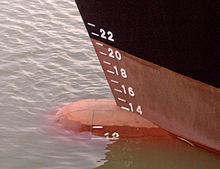
A Primer on Displacement
Often I obtain boat weights from a Marine Travelift’s operator and usually it is more than the listing specification’s displacement; I wonder why? Researching the answer (on Wikipedia, WoodenBoat forum and other on-line sources) enlightened me on a few interesting boating terms and concepts.
At the root is Archimedes’ Principle, displacement and buoyancy. Displacement is the weight of the water a boat displaces when floating still. In other words, the weight of the water that would be spilled out of a completely filled container when a boat is placed in it. Archimedes’ Principl![120px-Principio_di_Archimede_galleggiamento[1]](https://themarinesurveyors.com/wp-content/uploads/2016/03/120px-Principio_di_Archimede_galleggiamento1.png) e says that the weight of the boat is reduced by its volume multiplied by the density of the fluid. If the weight of the object is less than this displaced quantity the object floats, if more, it sinks.
e says that the weight of the boat is reduced by its volume multiplied by the density of the fluid. If the weight of the object is less than this displaced quantity the object floats, if more, it sinks.
A boat will displace the same weight of fluid, regardless of the fluid, thus it will sit lower in fresh water than salt water because fresh water is less dense. Thus the weight of the hull, structure and everything inside is precisely the displacement. There are physics arguments about weight being matter under the acceleration of gravity, blah, blah, blah and displacement being primarily about volume, (read – boring) but for us common boaters – forget about it, weight = displacement.
This concept only applies to boats afloat, when sunk they only displace the volume of material in the boat, not the weight. Equal size cubes of aluminum and gold displace the same amount when sunk. By the way, I solve sunken boat mysteries, and it’s always the same cause, too much water on the inside.
![220px-Draft_scale_at_the_ship_bow_(PIC00110)[1]](https://themarinesurveyors.com/wp-content/uploads/2016/03/220px-Draft_scale_at_the_ship_bow_PIC001101.jpg)
So why am I told boat weights that are more than published displacements? There is no standard for manufacturers’ published displacement and a lighter boat is often considered better by the buying public. The weight of a boat on a travel lift’s scale includes everything aboard, including equipment that has been added, personal effects, paint, varnish, spare parts, water and possibly absorbed water. The scales are not required to be certified, are rarely calibrated, and are primarily used for balancing the load. About one third of the travel lifts’ scales I use are completely inoperative, but these scales are usually our only option, so if you have your boat pulled out, ask for and record the weight.
If a true weight is desired or required (as in competitive sailboat racing) we rent and use a load cell as the weighing device. A weighbridge or truck scale is also very accurate but the opportunity to use one is rare, if you have your boat transported overland ask the trucker for the weight, it will be very accurate.
Now that we have cleared up weight, displacement and tonnage, how long do you think your boat is?
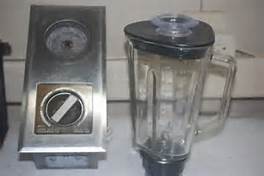
Tribute to the NuTone Blender
 The Nutone blender is a built in blender consisting of a motor which is mounted below a countertop with a rectangular stainless steel counter top fixture. The counter top fixture includes a round switch and a matching round cover for the rotating driver. Its flush mount and brown and stainless finish matched well with salmon countertops and avocado green appliances. The Nutone blender is one of the most iconic accessories on 1980’s motor vessels. It is a nostalgic device from my boating youth that brings a smile with each encounter.
The Nutone blender is a built in blender consisting of a motor which is mounted below a countertop with a rectangular stainless steel counter top fixture. The counter top fixture includes a round switch and a matching round cover for the rotating driver. Its flush mount and brown and stainless finish matched well with salmon countertops and avocado green appliances. The Nutone blender is one of the most iconic accessories on 1980’s motor vessels. It is a nostalgic device from my boating youth that brings a smile with each encounter.
Prior to my marine surveying career, which began in 1990, I captained several motor yachts in Florida. Most of these yachts were built in the United States or Taiwan, and most were equipped with the Nutone blender. In hot Florida climes, frozen margaritas and rum runners are logical first steps for a novice captain and bartender and thus began my love of the Nutone.
If you are unfamiliar with a Nutone blender, you haven’t paid attention when you were aboard vintage motor yachts. As iconic as the slinky and the pet rock, but much more practical, the Nutone is also a food processor and knife sharpener. That pipe smoking, smartly dressed yachtsman that you see walking down your dock has a Nutone on his vessel.
It should be noted that these blenders were not sold exclusively to vessels in hot climates. Lake Havasu City boat builders have no choice but to include this accessory as a standard option. “60 miles per hour with a blender” is a modern sales pitch in the desert, but the Nutone sales force cornered the world wide motor yacht market in the 1980’s. It was not only the most prolific blender aboard but the most prolific non-essential piece of galley equipment, far exceeding the Broan trash compactor.
Oh, what a cyclonic sales force Nutone must have employed in those whirl wind days. To this fantastic sales team and their incredible market share we have one clear and obvious salute… Cheers!
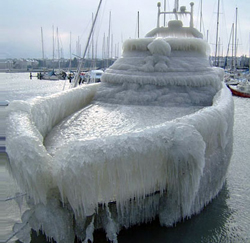
Winterizing Tips for Southern California
![Boat-Parade_Photo-Credit-John-Blom-Photography-1-1024x684[1]](https://themarinesurveyors.com/wp-content/uploads/2016/03/Boat-Parade_Photo-Credit-John-Blom-Photography-1-1024x6841.jpg) Highs in the 70’s and lows in the 50’s, that’s one reason we live here. Unless you leave your boat at a high elevation, you don’t need to worry about the engine block, gear case or exhaust manifold cracking. You don’t have to bother with filling the fresh water system with anti-freeze and you don’t have to haul the boat for the winter. So there are a lot of things you don’t need to do but what should you do?
Highs in the 70’s and lows in the 50’s, that’s one reason we live here. Unless you leave your boat at a high elevation, you don’t need to worry about the engine block, gear case or exhaust manifold cracking. You don’t have to bother with filling the fresh water system with anti-freeze and you don’t have to haul the boat for the winter. So there are a lot of things you don’t need to do but what should you do?
Prepare for the rain. Winter is our rainy season and whether your boat is stored in the water or on a trailer, a little preparation will minimize resulting damage. Boats on trailers or tenders on chocks should be stored bow up with the drain plug out. The bilge should be clear of debris that can plug the drain hole. Every spring we handle a few insurance claims due to “trailer submersions”. Covers should be inspected and serviced. They should be installed to prevent puddling, secure to prevent being blown loose and they should cover all the parts you don’t want exposed to the sun.![frozen_boat_250[1]](https://themarinesurveyors.com/wp-content/uploads/2016/03/frozen_boat_2501.jpg)
The rain is an easy way for you to find leaks, or at least to become aware they exist. Take the opportunity to maintain and rebed the deck hardware, service hatches, windows and port lights. Ventilate, by coming down and opening the boat up during the beautiful days and/or installing ventilation devices. Someone will come to their boat in the spring and be enlightened as to how fast mold (fungi) can grow. It won’t grow without significant moisture, which is the only factor you control.
While you are visiting the boat spend a few minutes operating the systems, run the engine, engage the transmission, flush the head, cycle pumps and motors and maybe go for a ride, you’re paying the So Cal lifestyle “tax”, you should enjoy it!
If your boat or tender has an outboard and you won’t use it for five months, run the gasoline out of the carburetor and fuel lines, consider stabilizing fuel and follow the manufacturer’s suggestions. Take measures to inhibit corrosion over the winter as appropriate. Service through hull valves, shut the valves that will not be used and make sure cockpit and deck drain valves are open. Check and service bilge pumps and their automatic switches, batteries and charging systems.
Thieves are aware you don’t come to your boat much. Make your boat less attractive to them, lock the doors and hide the key somewhere different or unique, not in the cockpit locker where all your neighbors hide their key. Conceal the pricey electronics and buy that live-aboard neighbor a bottle of her favorite wine to get a little more attention paid to your boat while you are away.
The winter is a good time to get some work done. The boatyards and trades are slower now than they will be in March. Many boatyards have specials during the holiday season for extended laydays and do-it-yourself projects.
Take advantage of your time and energy you are devoting to “winterizing”, by making your own custom check list. Do a little internet research, remember that lesson you learned, write it down and edit the list when you get more ideas, it will be a good read next winter.
Remember the San Diego Sunroad Boatshow is coming on January 23 – 26, 2014, see you there.

A good reason for a survey – through hulls
 Many of our jobs are requirements placed on boat owners. The need for an insurance policy or a loan, or a slip, etc… This story springs from a marina’s request for a survey.
Many of our jobs are requirements placed on boat owners. The need for an insurance policy or a loan, or a slip, etc… This story springs from a marina’s request for a survey.
The boat was a 40-year old 26’ fiberglass sailboat and transfer of ownership triggered the marina’s requirement for a marine survey.
During the survey, we discovered a badly corroded through hull and valve assembly and brought it to the attention of the owner. She asked if this would cause the boat to fail the survey (marine surveyor’s generally don’t give pass / fail grades). We responded that it was the marina who would decide whether the boat passed but we would suggest determining the condition of the through hull and replacing it if necessary.
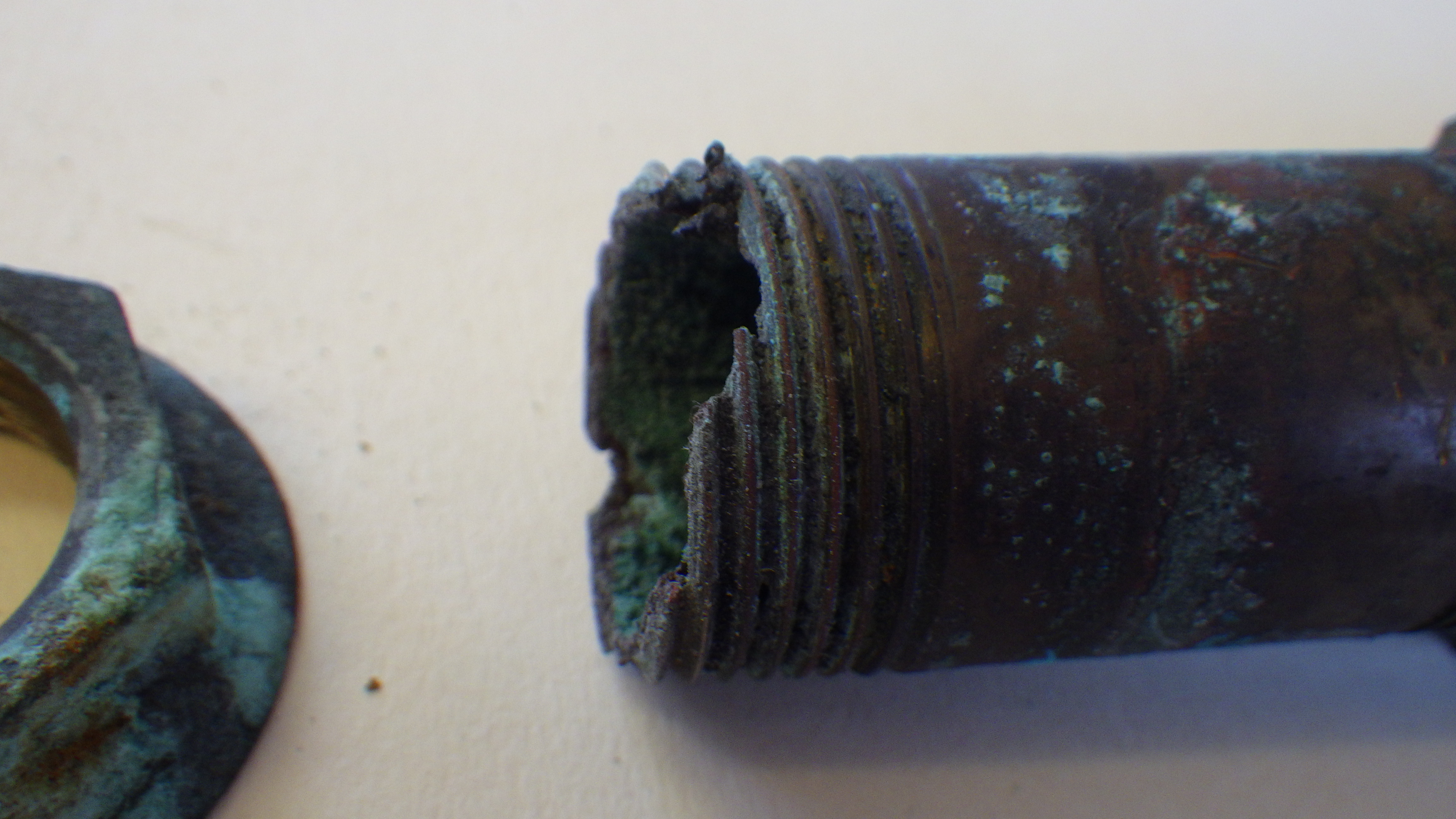
The intelligent, savvy owner asked how its condition should be determined. “Start by cleaning it” I responded.
Shortly thereafter the discussion led to the methods for cleaning and possible outcomes. I gave her advice based on my experience, which she later described as a premonition.
“Be careful with your cleaning, you may create a problem”, I cautioned. She said she had emergency dowel plugs to which I responded, “Sometimes the holes are smaller than the dowels”.
Within minutes a small leak turned into a trickle as the valve stem fitting detached from the valve. While a friend of hers whittled a wooden dowel plug down to the size of a small hole, we tried numerous other implements to stop the leak. A pencil, a chopstick, a rubber glove wrapped around a pen, and finally the pointy end of a tube of caulk did the trick.
I left the boat with the client on watch and the friend dispatched to find a suitably sized cap for the now open threaded hole.
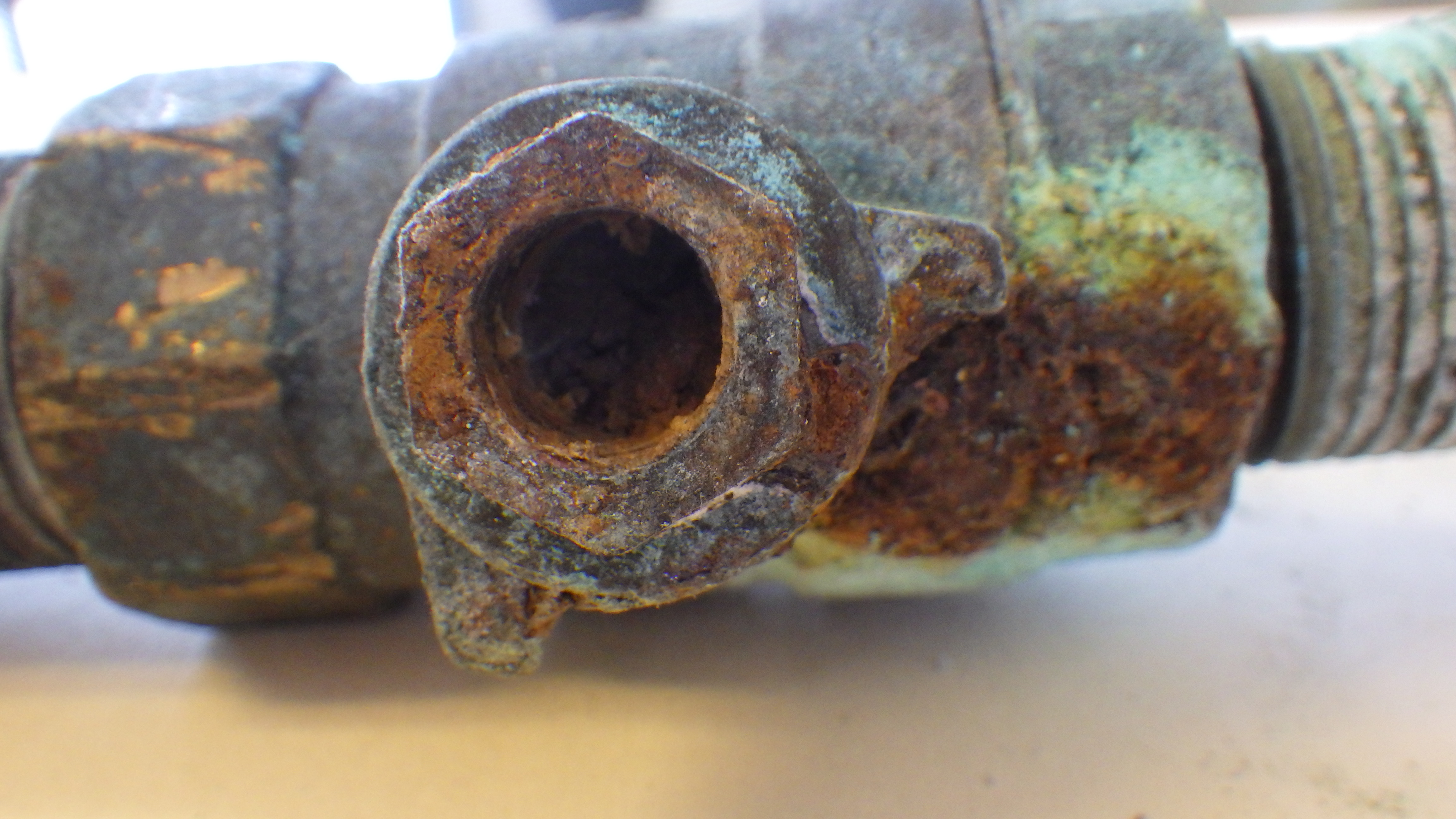
The through hull was relatively difficult to inspect and access, but once inspected, the poor condition was obvious. It certainly did not take a marine surveyor to find the deficiency, but in this case a marina’s request for a survey may have averted a minor catastrophe. The vessel had no bilge pump and the owner’s choice of cleaning implements was a paper towel, the fitting had not been far from failure.
Many times marine surveyors find expired flares and aged extinguishers, but sometimes they find something important. It doesn’t take a marine surveyor to find obvious problems like this one, but it does take a decision to look. How long since you have taken a look?

